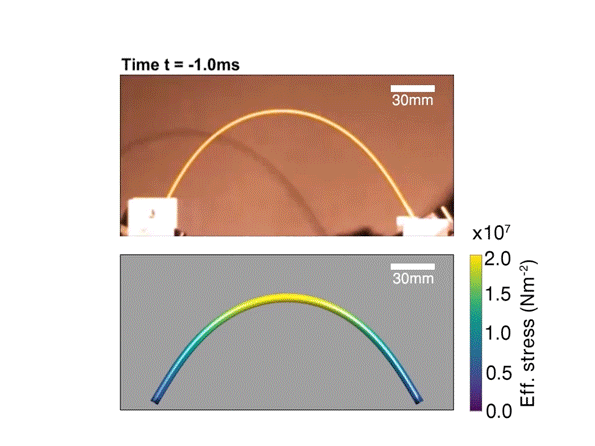
The MIT apparatus in action
In fact, even a great physicist Richard Feynman spent a good amount of time trying to solve the challenge by cracking spaghetti in two.
Unless you have a massive cauldron, the chances are you are not going to get the full-length spaghetti to fit into a pot all at once, leaving you with inconsistently cooked strands. If the answer is three or more, pull out another stick and try again.
Then, in 2015, two MIT students in search of a final project set out to discover if there was any way to control those natural forces to achieve a neat, clean break. He couldn't figure out a logical and theoretical explanation as to why the sticks refused to snap in two. After that, the spaghetti would break in two pieces.
For the study, Ronald Heisser, Vishal Patil, and other researchers snapped many spaghetti sticks to find out how to achieve a flawless two-piece break.
Researchers say the study has a goal beyond solving this pasta puzzle. In a paper published this week in the Proceedings of the National Academy of Sciences, researchers report that if you also twist the spaghetti, this dampens the shock wave and reduces the chance of breaking into several pieces.
Now, researchers at MIT have taken the issue on board and have devised a way in which to break dry spaghetti into two pieces rather than three or more. After that, Heisser and MIT grad student Vishal Patil ran tests on hundreds of spaghetti strands to record how each one of them broke.
They found that if a stick was twisted past a certain degree and further bent in half, it could be broken into two. Their co-authors are Norbert Stoop, instructor of mathematics at MIT, and Emmanuel Villermaux of Université Aix Marseille.
The spaghetti challenge isn't a recent mystery.
But a question remained: Could spaghetti ever be coerced to break in two?
"But you have to twist really strongly. And Ronald wanted to investigate more deeply".
Mueller Wants Papadopoulos to Go to Jail, Says He Harmed Russia Investigation
The court filing Friday states that Mueller's team is "aware that the defendant and his spouse have participated in several additional media interviews concerning his case".
So student Ronald Heisser built a machine to twist and bend the noodles.
Soon enough, Heisser constructed a special spaghetti-breaking device that was equipped with a clamp on either end that would tightly hold the strand.
Finally, the MIT team found out that the only way of breaking the spaghetti is to twist it past a critical degree and then bend it in half.
They found that if a 10-inch-long spaghetti stick is first twisted by about 270 degrees and then bent it will snap in two.
One caveat: the technique only works on cylindrical-rod shaped pasta like spaghetti (in this case, Barilla No. 5 and Barilla No. 7). Later, the French scientists received for their work the IG Nobel prize, came to the conclusion that spaghetti or any other thin rods break in the middle, there was a wave deformation, which violates the integrity of the rod in the other part. He, however, adapted their theory to include the element of twisting. The twist essentially weakens the snap-back effect discovered in 2006.
"Once it breaks, you still have a snap-back because the rod wants to be straight", Dunkel explains. "But it also doesn't want to be twisted".
The bending wave travels down the remaining strand of spaghetti before it relaxes and un-twists. Consider that, when an untwisted rod first fractures, each half catapults backward in a burst of kinetic energy.
People who have at least attempted to make a pasta dish know that it is impossible to snap a dry spaghetti into two pieces.
"It will be interesting to see whether and how twist could similarly be used to control the fracture dynamics of two-dimensional and three-dimensional materials", says Dunkel. By twisting and bending, the stress placed on the object being broken is distributed - weakening the "snapback effect" and allowing the pasta to release energy while it unwinds, thus preventing more fractures.
"Linguini is different because it's more like a ribbon", Dunkel says.
Bagikan Berita Ini














0 Response to "Snap that: Mystery of how to break spaghetti into two cracked!"
Post a Comment